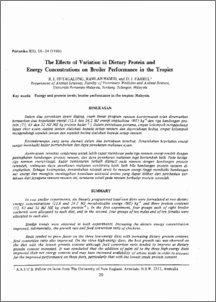Citation
Hutagalung, R. I. and Hamid, Ramlah and Farreli, D. J.
(1980)
The Effects of Variation in Dietary Protein and
Energy Concentrations on Broiler Performance in the Tropics.
Pertanika, 3 (1).
pp. 20-24.
Abstract
In two broiler experiments, six linearly programmed least~cost diets were formulated at two dietary
'energy concentrations (12.6 and 24.2 MJ metabolizable energy (ME) kg-I and three protein contents
(73, 63 and 52 MJ ME kg crude protein-I). In the first experiment, four groups each of eight broiler
cockerels were allocated to each diet, and in the second, four groups of ten males and often females were
allocated to each diet.
Similar trends were observed in both experiments. Increasing the dietary energy concentration
improved, substantially, the growth rate and feed conversion ratio of chickens.
Birds tended to grow faster on the three low-energy diets with increasing dietary protein content;
feed conversion ratio also improved. On the three high-energy diets, the best growth rate was observed on
the diet with the lowest protein content although feed conversion ratio tended to improve as dietary
protein content increased. It was concluded that the addition of palm oil to the three high-energe diets
improved their net energy content and may have increased availability of amino acids in order to account
for the improved performance on these diets, particularly that with the lowest crude protein content.
Download File
![[img]](http://psasir.upm.edu.my/style/images/fileicons/application_pdf.png)  Preview |
|
PDF
The_Effects_of_Variation_in_Dietary_Protein_and.pdf
Download (2MB)
|
|
Additional Metadata
Actions (login required)
 |
View Item |

